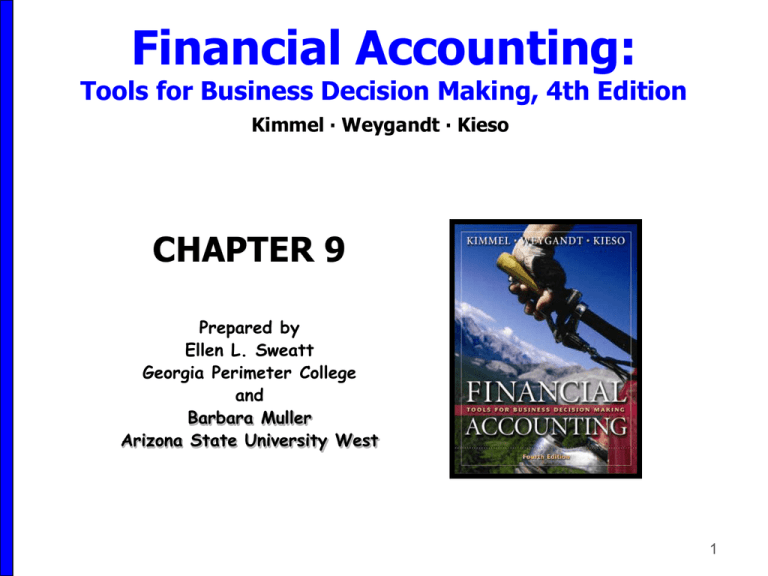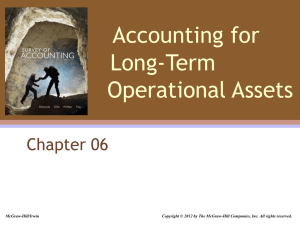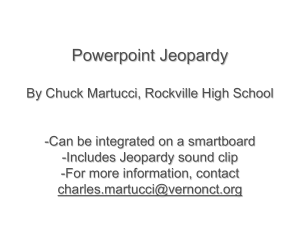
Financial Accounting:
Tools for Business Decision Making, 4th Edition
Kimmel ∙ Weygandt ∙ Kieso
CHAPTER 9
Prepared by
Ellen L. Sweatt
Georgia Perimeter College
and
Barbara Muller
Arizona State University West
1
Chapter 9
REPORTING AND
ANALYZING LONGLIVED ASSETS
2
Chapter 9
Reporting and Analyzing
Long-Lived Assets
After studying this chapter, you should be able to:
1. Describe how the cost principle applies
to plant assets.
2. Explain the concept of depreciation.
3. Compute periodic depreciation using the
straight-line method, and contrast its
expense pattern with those of other
methods.
4. Describe the procedure for revising
periodic depreciation.
3
Chapter 9
Reporting and Analyzing
Long-Lived Assets
5. Explain how to account for the disposal
of plant assets.
6. Describe methods for evaluating the use
of plant assets.
7. Identify the basic issues related to
reporting intangible assets.
8. Indicate how long-lived assets are
reported on the balance sheet.
4
1
11
Cost of Plant Assets
Plant assets are resources that
• have physical substance
• are used in the operations of a business
• are not intended for sale to customers
• deliver service potential over their useful
lives (except land)
Plant assets are recorded at cost
• cost consists of all expenditures
necessary to acquire the asset and
make it ready for its intended use
5
Types of Expenditures
Revenue Expenditure immediately charged
against revenue as an
expense
Capital Expenditure - capitalized as an
asset, not immediately expensed
6
Plant Assets
Cost is measured by
• the cash paid in a cash transaction, or
• the cash equivalent price paid when noncash
assets are used in payment.
The cash equivalent price is equal to
• the fair market value of the asset given up, or
• the fair market value of the asset received,
whichever is more clearly determinable.
7
Plant Assets
Land
Cost of land includes
• Cash price, closing costs, brokers’
commissions, accrued property taxes,
etc.
• Can also include costs to raze a building,
drain and fill the land
• Proceeds from sale of salvaged
materials are deducted from the cost
8
Cost of Land Improvements
All expenditures necessary to make
the improvements ready for their
intended use
•
•
•
•
Drive ways
Parking lots
Fences
Underground sprinklers
9
Buildings
All necessary expenditures relating
to the purchase or construction of
a building.
When a building is purchased such
costs include the
• purchase price
• closing costs (attorney's fees title
insurance)
• real estate broker's commissions
10
Buildings
If a building is purchased, but
needs to be readied for its
intended use, cost includes
• expenditures for remodeling
rooms or offices
• replacing or repairing
o roof
o floors
o electrical wiring
o plumbing
11
Buildings
When a building is constructed, its
cost consists of
•
•
•
•
•
the contract price
architect's fees
building permits
excavation cost
interest costs during
construction
12
Equipment
Cost of equipment
includes
• purchase price
• sales tax
• freight charges and insurance
during transit paid by the
purchaser
• expenditures required in
assembling
• installing and testing the unit
13
Equipment
Two criteria apply in determining the cost
of equipment
• the frequency of cost - one time or recurring
• the benefit period - the life of the asset or 1
year
14
Leasing Versus Purchasing an Asset
Advantages of leasing include
•
•
•
•
Reduced risk of obsolescence
Little or no down payment
Shared tax advantages
Assets and liabilities may not be recorded
15
Review Question
Which of the following is/are properly
classified as plant assets (property,
plant, and equipment)?
I.
II.
III.
a.
b.
c.
d.
Inventory
Machinery
Office supplies
I and II only.
II and III only.
II only.
III only.
16
Review Question
Which of the following is/are properly
classified as plant assets (property,
plant, and equipment)?
I. Inventory
II. Machinery
III. Office supplies
a.
b.
c.
d.
I and II only.
II and III only.
II only.
III only.
17
Review Question
a.
b.
c.
d.
Real estate fees incurred to
purchase a building are treated on
the financial statements as an?
Expense in the period incurred.
Expense in the period the fees are
paid.
Extraordinary expense, reported
net of tax.
Asset.
18
Review Question
a.
b.
c.
d.
Real estate fees incurred to
purchase a building are treated on
the financial statements as an?
Expense in the period incurred.
Expense in the period the fees are
paid.
Extraordinary expense, reported
net of tax.
Asset.
19
2
11
Depreciation
The process of allocating to expense the cost of
a plant asset over its useful life in a rational and
systematic manner.
• Depreciation is not a process of asset valuation.
20
Depreciation
Three classes of plant assets are
depreciated
• Land improvements
• Buildings
• Equipment
Land is NOT depreciated
21
Depreciable Assets
The revenue-producing ability of an asset
declines during its useful life because of
wear and tear.
A decline in revenueproducing ability may
also occur because of
obsolescence.
22
Land
Does not depreciate since its usefulness and
revenue producing ability generally remain
intact, or increase.
23
Accumulated Depreciation
• The balance in Accumulated Depreciation
is
• The total amount of the asset’s cost charged
to expense to date
• Not a cash fund
24
Factors in Computing
Depreciation
25
Review Question
Depreciation is a process of?
a. Valuation.
b. Cost allocation.
c. Cash accumulation.
d. Appraisal.
26
Review Question
Depreciation is a process of?
a. Valuation.
b. Cost allocation.
c. Cash accumulation.
d. Appraisal.
27
3
11
Depreciation Methods
Straight-line
Declining-balance
Units-of-activity
28
Straight-line Method
Depreciable Cost*
______________________________________________________________________________________
The asset's useful life measured in years
*(cost of the asset less its salvage value)
29
Straight-Line Depreciation
Formula
30
Straight-line Method
Is the most
widely used
method of
depreciation.
Depreciation is
the same for
each year of the
asset's useful
life.
31
Partial Year Depreciation
If an asset is purchased during the year
rather than on January 1, the annual
depreciation is prorated for the
proportion of a year it is used.
32
Declining-Balance Method
Is an accelerated
method.
Accelerated
methods of
depreciation result
in more
depreciation in the
early years of an
asset's life and less
depreciation in the
later years.
33
Units-of-Activity Method
The life of an asset is
expressed in terms
of the total units of
production or the
use expected from
the asset.
The amount of
depreciation is
proportional to the
activity that took
place during the
period.
34
Patterns of Depreciation
35
Depreciation and Income Taxes
• The IRS allows corporate taxpayers to
deduct depreciation when computing
taxable income.
• The IRS does not require the taxpayer to
use the same depreciation method on the
tax return that is used in preparing
financial statements.
36
Depreciation and Income
Taxes
Many large corporations use straight-line depreciation in
their financial statements to maximize net income.
At the same time they use a special accelerateddepreciation method on their tax returns to minimize
their income taxes.
The choice of depreciation method
must be disclosed in the
notes to financial statements.
37
4
11
Revising Periodic
Depreciation
A change in estimate (estimated useful life,
estimated salvage value, etc.) affects current
and future years but not prior periods.
Significant changes in estimate must be
disclosed in the financial statements.
Extending an asset's estimated life reduces
depreciation expense and increases net income
for the period.
38
Expenditures During Useful Life
Ordinary Repairs
• are expenditures to maintain the
operating efficiency and expected
productive life of the asset.
• are usually small in amount that
occur frequently throughout the
service life.
• examples include oil changes on
vehicles and painting of buildings.
39
EXPENDITURES DURING USEFUL LIFE
Additions and Improvements
• are expenditures incurred to increase the
operating efficiency, productive capacity,
or expected useful life of the plant asset.
• are usually material in amount and occur
infrequently during the period of
ownership.
• are capital expenditures.
40
Impairments
A permanent decline in the market value
of an asset.
The asset is written down to the new
market value during the year in which
the decline occurs.
41
Review Question
The main reason companies record
depreciation expense is?
a. For tax purposes.
b. To establish a fund for replacing
depreciable assets.
c. To systematically allocate the
asset’s cost over its useful life.
d. As an “earnings management”
technique.
42
Review Question
The main reason companies record
depreciation expense is?
a. For tax purposes.
b. To establish a fund for replacing
depreciable assets.
c. To systematically allocate the
asset’s cost over its useful life.
d. As an “earnings management”
technique.
43
Review Question
True or False?
The double-declining balance
method of deprecation usually
results in the least rapid decrease
in an asset’s book value.
44
Review Question
True or False?
The double-declining balance
method of deprecation usually
results in the least rapid decrease
in an asset’s book value.
FALSE
45
5
11
Plant Asset Disposals
46
Sale of Plant Assets
In the sale of an asset, the book
value of the asset is compared with
the proceeds from the sale.
• If the proceeds exceed the book
value a gain on disposal occurs.
• If proceeds from the sale are less
than the book value a loss on
disposal occurs.
47
Retirement of Plant Assets
A retirement is recorded by
• decreasing Accumulated Depreciation for the
full amount of depreciation taken over the life
of the asset, and
• decreasing the asset account for the original
cost of the asset.
The loss is equal to the asset's book
value at the time of retirement (a gain is
not possible).
48
6
11
Analyzing Plant Assets
The two measures by which a company’s
use of its plant assets is evaluated are
• Return on Assets Ratio
• Asset Turnover Ratio
49
Return on Assets Ratio
Indicates the amount of net income
generated by each dollar invested in assets
50
Asset Turnover Ratio
Indicates (1) how efficiently a company uses its
assets, and (2) how many dollars of sales are
generated by each dollar invested in assets?
51
Analyzing Plant Assets
A company can increase its return on
assets by (1) increasing profit per sale as
measured by profit margin ratio, or (2)
increasing its volume of sales as
measured by the asset turnover ratio
52
7
11
Intangible Assets
Intangible assets are rights,
privileges, or competitive
advantages
Intangible assets result from
ownership of long-lived assets that
do not possess physical substance
Intangible assets are often a
company’s most valuable assets
53
Types of Intangible Assets
Patents
Copyrights
Trademark or Trade Names
Franchises and Licenses
Goodwill
PATENT
54
Intangible Assets
Intangible assets are recorded at cost
If the intangible has a limited useful life,
its cost is allocated (amortized) over the
useful life.
If the intangible has an indefinite life, it is
not amortized.
55
Patents
Patents are an exclusive right that enables
the recipient to manufacture, sell, or
control a patent for 20 years from the date
of grant.
The initial cost of a patent is cash or cash
equivalent price paid to acquire the patent.
Legal costs of protecting a patent are
added to the Patent account and amortized
over the remaining life of the patent.
56
Research and Development
Costs
R&D costs are expenditures that may
lead to a patent, copyright, or other
intangible asset
R&D costs are not intangible assets
R&D costs are usually expensed as
incurred
57
Copyrights
Copyrights are granted by the federal
government giving the owner the
exclusive right to reproduce and sell
artistic or published work.
Copyrights extend for the life of the
creator plus 70 years.
58
Trademarks/
Trade Names
A word, phrase,
jingle,or symbol
that distinguishes
or identifies a
particular
enterprise or
product.
59
Franchises and Licenses
A franchise is a contractual agreement under
which the franchiser grants the franchisee the
right (within a designated geographic area)
• to sell certain products
• to render specific services, or
• to use certain trademarks or trade names
When costs can be identified with the
acquisition of the franchise or license, an
intangible asset should be recognized
Annual payments made under a franchise
agreement should be recorded as operating
expenses
60
Goodwill
Goodwill represents the value of all
favorable attributes that relate to a
business enterprise, including
•
•
•
•
exceptional management
desirable location
good customer relations
skilled employees
Goodwill cannot be sold individually, it is
associated with the business as a whole
Goodwill is only recorded when an entire
business is purchased
61
8
11
Presentation Of Long-lived
Assets
Plant assets are shown in the
financial statements under
Property, Plant, and Equipment.
Intangibles are shown
separately under
Intangible Assets
62
Presentation Of Long-lived
Assets
Contra accounts
• Plant assets make use of a contra account “Accumulated
Depreciation”
• Amortization of intangible assets is generally recorded
directly to the asset account, bypassing the use of a
contra account
Disclosures include major classes of assets
and methods of depreciation
63
Review Question
a.
b.
c.
d.
Which of the following is not
considered an intangible asset?
Franchise.
Natural gas.
Patent.
Goodwill.
64
Review Question
a.
b.
c.
d.
Which of the following is not
considered an intangible asset?
Franchise.
Natural gas.
Patent.
Goodwill.
65
Review Question
Intangible assets?
a. Have physical substance.
b. Have no real economic value.
c. Can often be bought and sold.
d. Are not expensed (through
amortization) over their useful life.
66
Review Question
Intangible assets?
a. Have physical substance.
b. Have no real economic value.
c. Can often be bought and sold.
d. Are not expensed (through
amortization) over their useful life.
67
Copyright © 2007 John Wiley & Sons, Inc. All rights
reserved. Reproduction or translation of this work
beyond that named in Section 117 of the United States
Copyright Act without the express written consent of the
copyright owner is unlawful. Request for further
information should be addressed to the Permissions
Department, John Wiley & Sons, Inc. The purchaser
may make back-up copies for his/her own use only and
not for distribution or resale. The Publisher assumes no
responsibility for errors, omissions, or damages, caused
by the use of these programs or from the use of the
information contained herein.
68







